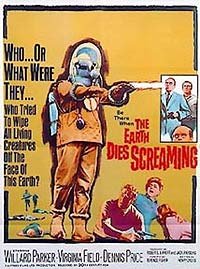Earth Dies Screaming, The |
|
UK • 1964 • 62m •
     • Directed by: Terence Fisher. • Starring: Willard Parker, Virginia Field, Dennis Price, Thorley Walters, Vanda Godsell, David Spenser, Anna Palk. • Music by: Elisabeth Lutyens. • Directed by: Terence Fisher. • Starring: Willard Parker, Virginia Field, Dennis Price, Thorley Walters, Vanda Godsell, David Spenser, Anna Palk. • Music by: Elisabeth Lutyens.     A heroic astronaut returns from a test flight to discover that most of England has been utterly destroyed by alien invaders, whose armies of killer robots have transformed nearly all of their victims into zombies. Parker manages to rally together a small resistance army from a few scattered survivors in outlying villages, and they eventually find the earth-based relay point for the transmissions which have enabled the invaders to coordinate the robot attack by remote control. A heroic astronaut returns from a test flight to discover that most of England has been utterly destroyed by alien invaders, whose armies of killer robots have transformed nearly all of their victims into zombies. Parker manages to rally together a small resistance army from a few scattered survivors in outlying villages, and they eventually find the earth-based relay point for the transmissions which have enabled the invaders to coordinate the robot attack by remote control.
|
Trailers:
| Length: | Languages: | Subtitles: |
Review:













At the heart of TEDS are three relationships: that between Quinn Taggart (a splendidly caddish Dennis Price) and Peggy (Virgina Field); the often drunk Otis (Thorley Walters) and his party friend Violet (Vanda Godsell), as well as the young couple Mel (David Spenser) with the pregnant Lorna (Anna Palk). Independent of this group is Jeff Nolan, played by the film's sole American actor. Producer Lippert had a successful formula of adding transatlantic appeal to films by stocking them with token imported talent. Here Willard Packer fits the bill. Packer is the man taking charge of events, organising the survivors, and figuring it out – right down to where the alien's transmitter can be found. He can be seen, in his mild way, as a typical 'Quatermass' figure: a technically competent individual taking charge to protect British society from intrusion. While no pure scientist, Nolan still has enough know-how to quickly grasp what has happened, how the invasion can be thwarted and to take decisive action. By the end of the film, he wins the right to a relationship of his own.
Critics such as Peter Hutchings in 'We're All Martians Now' (British Science Fiction Cinema (Routledge, 1999)) have identified such influential figures as typically being a 'boffin-like protector of a society which seems incapable of protecting itself'. At the same time, through the imported novelty of his presence, Nolan is a reminder of British insularity. At time many of these films appeared British society was still relatively isolated, but under pressure from new pressures and changes, both international and local. Only the cynical Taggart has a competing world-view in the film that's as strong as Nolan's. For Taggart the new global conflict is over. Worse, "whoever did it has won its every man for himself" - fatalistic sentiments in stark contrast to the famous spirit of the blitz, striking to many of those watching then. The punishment for his criminality and selfishness will be the loss of his tenuous relationship with Peggy and, ultimately his humanity, part of the alien zombie army.
The biggest social change in Fisher's film is obvious – a successful first strike against British society, together with silver-clad aliens walking the streets, zombie workforce in support. Blank-eyed and as slow-moving as their masters, these zombies are among the most effective elements in the film. They must have been rather a novelty to contemporary audiences. I can't, off-hand, think of an earlier representation of the creatures in British cinema before this (Hammer's Plague of the Zombies appeared two years later, but even so is set in the past). They provide one of the highlights of the film – a scene when Peggy is pursued, then trapped breathlessly in a bedroom closet, when Fisher makes use of a very dramatic close up to add terror.
In contrast to the unsuccessful efforts of the un-dead to find a female, Nolan succeeds in gradually establishing a relationship and, one presumes, goes on to a successful romance. His success against the invader acts as a catalyst. By the end of the film he is entitled to reintegrate back in society. There's a parallel to be found between the zombie's painfully slow pursuit search and unnerving, soulless staring at the closet in which Peggy hides to another scene where Nolan had looked on, affectionately, as she pottered over small things in the pub's kitchen. The difference between humanity and the alien, the film suggests, is that the former can bring value and sentiment to what it sees and so, once again, the British invasion variant gravitates naturally to the domestic.
TEDS is further helped by a very effective score by Elizabeth Lutyens, as well as some crisp, atmospheric cinematography by Arthur Lavis, especially effective when shooting on village location. These are elements that help to make it my favourite out of Fisher's small group of SF movies, a feeling which even the over-acting of Walters can't dissipate. It 's also blessed with a dramatic pre-title sequence - a world wrecked by sudden accident, recalling the night before Day of the Triffids, as well as an eerie sense of a familiar landscape made empty, a horror-fantasy tradition which persists right down to such British films as 28 Days Later. Fisher's film may be short, cheap, and with a disappointingly flat denouement, but its modest pleasures easily invite revival.
Review by FilmFlaneur from the Internet Movie Database.
Off-Site Reviews:
Movie Database
